Fungal spores are microscopic biological particles that allow fungi to be reproduced, serving a similar purpose to that of seeds in the plant world. Fungi decompose organic waste and are essential for recycling of carbon and minerals in our ecosystem. It has been estimated that fungi recycle millions of tons of organic waste annually.
There are thousands of different fungi in the world which are essential for the survival of other organisms. Unfortunately, fungi produce lots of spores that can also be detrimental to humans.
Health effects of fungal spores
Many fungal spores contain allergens which can trigger a range of respiratory symptoms in those susceptible. These symptoms include sneezing, runny nose, mucous production, cough, congestion, sinusitis, earache, headache, wheezing, asthma and a range of bronchial symptoms and diseases. It is estimated that around 3-4% of the general population get allergy symptoms from fungal spores, including the majority of asthma sufferers. Many fungal spore types have similar allergens which are released at different times of the year. This means that sufferers of fungal spore allergies are likely to be sensitive to many types for large parts of the year.
Main types of fungal spore
Fungi come in a wide range of types and sizes, most are microscopic but some, such as mushrooms and bracket fungi, are quite large. Fungal spores themselves are all microscopic, some as small as two micrometres in size. Most fungi require warmth and humidity to grow, reproduce and release their spores into the environment. Many fungi produce only small amounts of spores which rarely get airborne in quantity. However, some species are very prolific and widespread, producing high concentrations of spores which are readily dispersed into the atmosphere. The main types that trigger most symptoms in allergy sufferers are: Alternaria, Cladosporium, Epicoccum, Aspergillus, Penicillium, Didymella, Pleospora and a group of species collectively referred to as Basidiospores. Also important to asthma sufferers are Sporobolomyces and Tilletiopsis, which are very small spores produced primarily during warm, humid nights.
Seasonal Spore Summary
Fungal spores are released on a seasonal basis. Many types can be found in the air all year round, typically peaking in the summer or late autumn.
Allergenic fungal spore calendars
These show the monthly average totals of spores per cubic metre of air, for the five year period, 2006-2010. The concentrations of spores produced by fungi vary greatly. For example, the Alternaria peak monthly average spore concentration is 3400, while for Cladosporium it is 210,000 and for Didymella 35,000. As a result, the thresholds for symptoms will also vary. However, thresholds have only been ascertained for Alternaria and Cladosporium so far.
The calendars have been produced by averaging 5 years of data collected in Worcester. Worcester is located in the centre West of the country and receives high amounts of pollen and spores due to very suitable weather and sources. Although the trends shown will be similar for much of the country, the average amounts will tend to be lower in western coastal regions and mountainous areas. The spore seasons in Northern Ireland, Scotland and the far North England will also start a few days to two weeks later than in the more southerly regions. A weekly spore forecast for spores is available here.
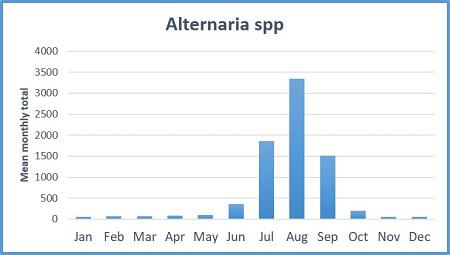
Alternaria
The first high days (>50 spores per cubic metre of air, daily average) start occurring in July. The peak average monthly total occurs in August (3400 spores) then in September high counts continue but go into decline.
All other months are very low. Download the Alternaria seasons charts from 2020 to 2022.
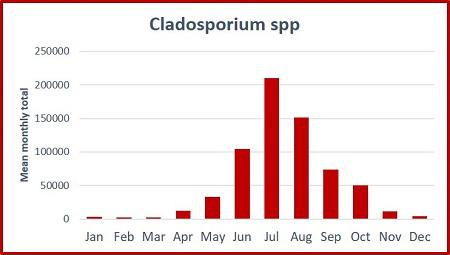
Cladosporium
November to March are very low for this type. The high threshold (>3000 spores per cubic metre of air, daily average) starts to be reached in late May. In June, the average monthly total reaches 104,000, in July 210,000 and in August 152,000. The spores go into decline in mid-September, with just occasional high days during warm weather.
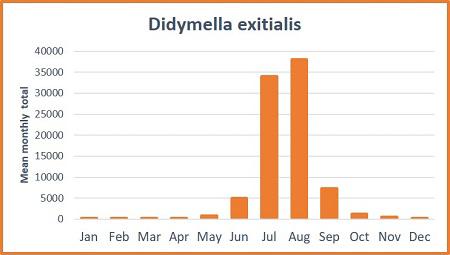
Didymella exitialis
October to May are very low for this type. The peak period is well defined, starting in late June and reaching peak period in July, which continues through August with a monthly average peak total of 35,000 spores.
There may be a few high days in early September then the risk drops to very low.
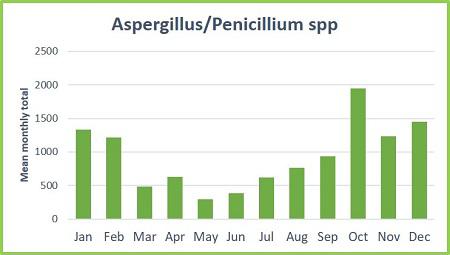
Aspergillus and Penicillium types
The year starts with a high risk for these types with a total monthly average of 1,333 spores in January and 1,215 in February. Spores continue to be airborne during Spring and early Summer but possibly below the levels needed to trigger symptoms. From mid-August the risk starts to rise again and people often report various respiratory symptoms during warm and humid conditions in late August, September and October, with the peak reaching an average of 1,950 spores in October. Aspergillosis sufferers report symptoms worsen in late Feb/March and again in August through to late October, with October the worst month. Although the spore levels continue to be high during November and December, few people report symptoms, so it is likely that the types occurring during these months are less allergenic.
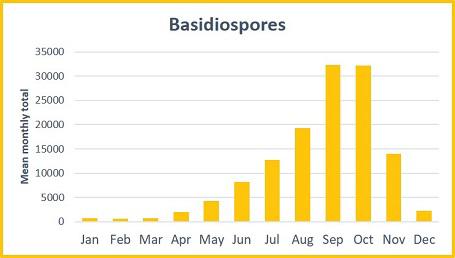
Basidiospores
The peak monthly total occurs in September for this type at 32,350 spores, after gradually increasing over the summer months. October is also a peak month, with a similar total.
The risk drops rapidly down to low by December. January through to early June are low for these spores.
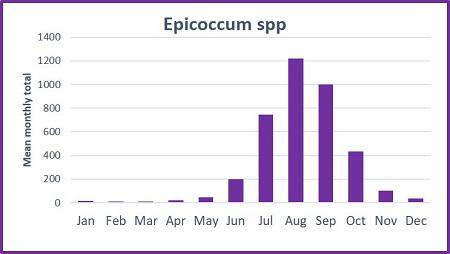
Epicoccum
January to early June remain low for this type, with the increase starting during warm weather from mid-June.
The peak monthly total occurs in August at 1,218 spores, September sees a similar high at 1,000 spores and then the season goes into decline through October, returning to low in November and December.
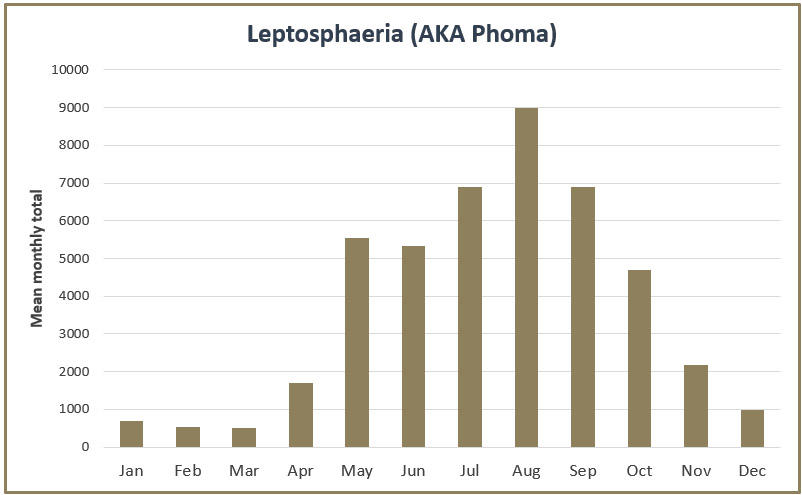
Leptosphaeria
Leptosphaeria (or Phoma) fungi mainly occur in crop-growing areas (especially where one of their major hosts, oilseed rape, is grown). The spores are liberated during or after rain and are rarely present during dry weather. Spores can be emitted at any time of year during rainfall but the levels really start to increase during wet weather in April and May, continuing at a high risk until late October or early November. Very dry months have lower levels of Leptosphaeria compared to the average.
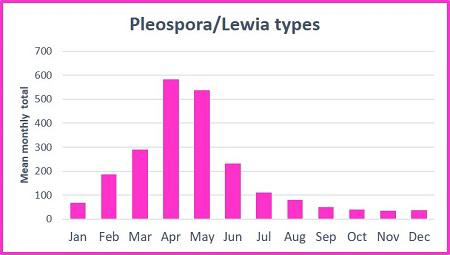
Pleospora
This type is low in January then there is an increase through February and March culminating in a peak in April and May (590 & 540 spores, respectively).
Thereafter, the risk drops off back to low levels from late June onwards.
Pollen Calendar Reference:
Sadys M, Adams-Groom B, Herbert RJ, Kennedy R. (2016) Comparisons of fungal spore distributions using air sampling at Worcester, England (2006-2010). Aerobiologia, 32(4): 619-634
Spore levels show trends throughout the year:
Spring:
In the Spring, most spore types are at low levels, apart from Pleospora. Cladosporium and Tilletiopsis can start increasing in May if the weather is warm and dry.
Summer to early Autumn:
The spore risk starts to rise in mid-June with the increase in temperatures. The risk peaks in late June/early July and continues until late September. Typically, during the day, there will be the ‘dry-weather’ spore types of Alternaria & Cladosporium and some types of Penicillium and Aspergillus. ‘Wet-weather’ spores respond to the dew during the night, such as Didymella, Sporobolomyces and Tilletiopsis. Therefore, there are a wide range of types that can affect people during each 24 hour period. In addition, rainfall will help the production of spores which are then released after heavy rain or during light showers or drizzly rain. There is a lower spore risk in very windy, unusually cold and dry weather. When late August and September are warm and humid, Penicillium and Aspergillus types can become very problematic for those affected by them, triggering a range of symptoms including hay fever, mucous production, cough, wheezing and asthma.
Mid-Autumn:
Penicillium and Aspergillus types can continue to be quite high into October - and even November and early December if temperatures remain mild. There are usually some of these spores present in the air throughout the Autumn and even lower levels can trigger some symptoms. Many other spore types are starting to decline, but the risk can be moderate to high on warmer, humid days. By the end of November, the risk decreases to low unless it is very mild and damp. The lowest risk is on dry, cold frosty days. Spores from mushrooms and bracket fungi reach their peak at this time of year, particularly in rural areas, although the risk is low to moderate for most spore sufferers as these are milder allergens.
Winter:
Aspergillus and Penicillium types quite often have a second peak in January and early February. Other spore types are low in Winter, although Pleospora can start increasing from February.
Types of Spore
Alternaria
Habitat / Substrates:
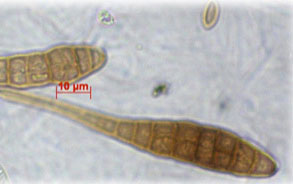
Alternaria fungi produce highly allergenic spores across quite a few species, the most potent of which is Alternaria alternata. This species causes leaf spot fungus on a wide range of plants, including cereals and grasses. As a result, the spores are abundant during the main season. Alternaria can also occur indoors on foodstuffs, carpets, textiles and window frames. Fungal colonies are usually black or grey.
Season:
The risk from Alternaria is high from mid-July to mid-September. Alternaria fungi require a temperature threshold of about 20oC to start spore production. The first peak of Alternaria spores usually occurs after a warm, dry spell followed by rain, then another warm, dry period for spore release. Thereafter, further peaks occur following the same weather patterns. During the harvesting of cereal crops we often see the greatest release of Alternaria spores. In 2019, conditions during the summer and again during harvesting were perfect for the production and release of Alternaria spores so the concentrations were excessively high.
Allergenicity:
High
Alternaria Research
Aspergillus/Penicillium
Habitat / Substrates:
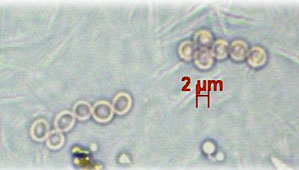
There are many species of Aspergillus and Penicillium, which live on a wide range of substrates. The spores can be very prevalent during the peak periods, triggering a range of respiratory problems. The spores are particularly prevalent in wooded areas, compost heaps, rotting wood chips and bark mulch. Some species rot down pine needles, so conifer plantations should be avoided during Autumn and again in January/February. Aspergillus/penicillium types also occur indoors, such as on food and on houseplants. If you’re keen to have houseplants, only have cacti, which require dry conditions, and ensure the soil surface is covered in a good layer of grit. High humidity encourages the growth and sporulation of fungal spores, so try to keep the home dry and ventilated. Face masks can be useful in preventing the breathing in of the tiny spores of Aspergillus/penicillium, as well as other spore types too.
Season:
Aspergillus and Penicillium spores are present in the air throughout the year but the main peak periods are late August to October and January to February.
Allergenicity:
High for some types, particularly A. fumigatus and P. chrysogenum. A. fumigatus is a major cause of aspergillosis (farmer’s lung).
Aspergillus Research
Penicillium Research
Cladosporium
Habitat / Substrates:
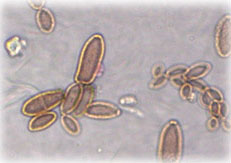
Cladosporium can be found on a wide range of plant substrates and in soil. Indoor substrates include paint and textiles. The mould colonies are generally black or olive-brown to brown.
Season:
The main season runs from May to October, with a peak starting in June and running until mid-September. The spores are released during dry weather and the highest risk occurs on warm, sunny days.
Allergenicity:
High
Cladosporium Research
Didymella
Habitat / Substrates:
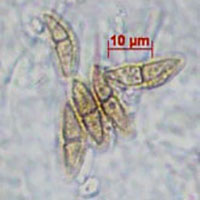
Didymella exitialis is the most important species of the genus for allergy and asthma sufferers because of its wide distribution, growing on grasses and cereal crops. Other types are found locally on infected cucurbit crops, such as pumpkins or courgettes (D. bryoniae) and on tomato plants (D. lycopersici).
Season:
Didymella fungi need warmth and high humidity to reproduce and emit spores. Warm, humid nights provide the right conditions, when spore levels can soar. Didymella spore levels reduce to low during warm, dry day-time hours. The main season occurs from late June to early September.
Allergenicity:
High. D.exitialis can cause severe asthma.
Didymella Research
Epiccocum
Habitat / Substrates:
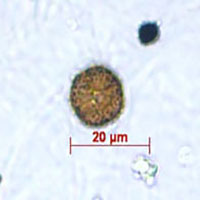
Epiccocum can be found outdoors and is widespread on soil and plant debris. Indoor substrates include paper and textiles.
Season:
The main season is July to September.
Allergenicity:
High
Basidiospores
Habitat/substrates
This name is a group term for the spores of a wide range of fungi but is used here and in forecasting to primarily describe the spores from mushrooms and bracket fungi. The most widespread type is Ganoderma (a type of bracket fungus) that produces spores all year but particularly in summer and early autumn. Rural, lowland areas of broadleaf woodland and unimproved grassland provide the best homes for mushrooms, toadstools and bracket fungi.
Season:
Basidiospores are most prevalent in the air during warm, dry weather in the autumn. The main period of release is from July to early November.
Allergenicity:
Moderate generally. High for Ganoderma.
Pleospora
Habitat/substrates
Pleospora are in the same fungal family as Alternaria and have shared allergens. Pleospora species grow on a wide range of herbaceous plants and grasses. Pleospora is a cause of brown spot on pear trees, purple spot on asparagus and lesions on potato leaves. As a result they are widespread in the environment.
Season:
Pleospora spores start to increase in late January to February and peak in late March to early June.
Allergenicity:
Not known but since it has shared allergens with Alternaria, is likely to be high.
School of Science and Environment
If you are interested in fungal spores, you may also be interested in our courses.